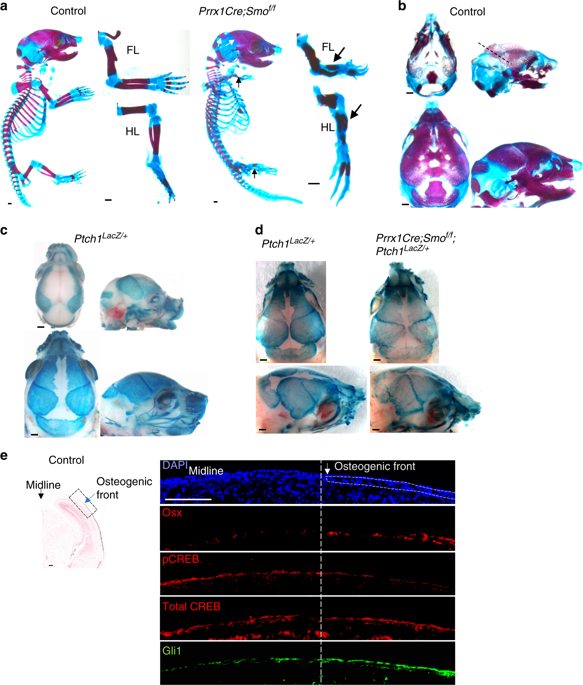Bone Research ( IF 14.3 ) Pub Date : 2018-11-20 , DOI: 10.1038/s41413-018-0034-7 Ruoshi Xu 1, 2 , Sanjoy Kumar Khan 1 , Taifeng Zhou 1, 3 , Bo Gao 1, 4 , Yaxing Zhou 1 , Xuedong Zhou 2 , Yingzi Yang 1

|
How osteoblast cells are induced is a central question for understanding skeletal formation. Abnormal osteoblast differentiation leads to a broad range of devastating craniofacial diseases. Here we have investigated intramembranous ossification during cranial bone development in mouse models of skeletal genetic diseases that exhibit craniofacial bone defects. The GNAS gene encodes Gαs that transduces GPCR signaling. GNAS activation or loss-of-function mutations in humans cause fibrous dysplasia (FD) or progressive osseous heteroplasia (POH) that shows craniofacial hyperostosis or craniosynostosis, respectively. We find here that, while Hh ligand-dependent Hh signaling is essential for endochondral ossification, it is dispensable for intramembranous ossification, where Gαs regulates Hh signaling in a ligand-independent manner. We further show that Gαs controls intramembranous ossification by regulating both Hh and Wnt/β-catenin signaling. In addition, Gαs activation in the developing cranial bone leads to reduced ossification but increased cartilage presence due to reduced cartilage dissolution, not cell fate switch. Small molecule inhibitors of Hh and Wnt signaling can effectively ameliorate cranial bone phenotypes in mice caused by loss or gain of Gnas function mutations, respectively. Our work shows that studies of genetic diseases provide invaluable insights in both pathological bone defects and normal bone development, understanding both leads to better diagnosis and therapeutic treatment of bone diseases.
中文翻译:

Gαs信号通过调节刺猬和Wnt /β-catenin信号控制颅骨发育过程中的膜内骨化。
如何诱导成骨细胞是理解骨骼形成的核心问题。成骨细胞的异常分化导致广泛的毁灭性颅面疾病。在这里,我们研究了在颅骨遗传疾病的小鼠模型中颅骨发育过程中的膜内骨化,这些疾病表现出颅面骨缺损。所述GNAS基因编码Gα小号该转导的GPCR信号传导。GNAS人类的激活或功能丧失突变会引起纤维增生(FD)或进行性骨异型增生(POH),分别显示颅面肥大或颅突增生。我们发现在这里,虽然的Hh配体依赖性Hh信号是软骨内骨化必不可少的,它是可有可无的膜内成骨,其中Gα小号的调整对象中的Hh配体无关的方式信号。进一步的研究表明Gα小号控制通过调节两者的Hh和Wnt /β-catenin信号膜内成骨。此外,Gα s ^发育中的颅骨中的活化导致骨化减少,但由于软骨溶解减少而不是细胞命运转换而增加了软骨的存在。Hh和Wnt信号转导的小分子抑制剂可以有效改善小鼠中由Gnas功能突变的丧失或获得引起的颅骨表型。我们的工作表明,遗传疾病的研究为病理性骨缺损和正常骨发育提供了宝贵的见识,对两者的了解有助于更好地诊断和治疗骨病。











































 京公网安备 11010802027423号
京公网安备 11010802027423号